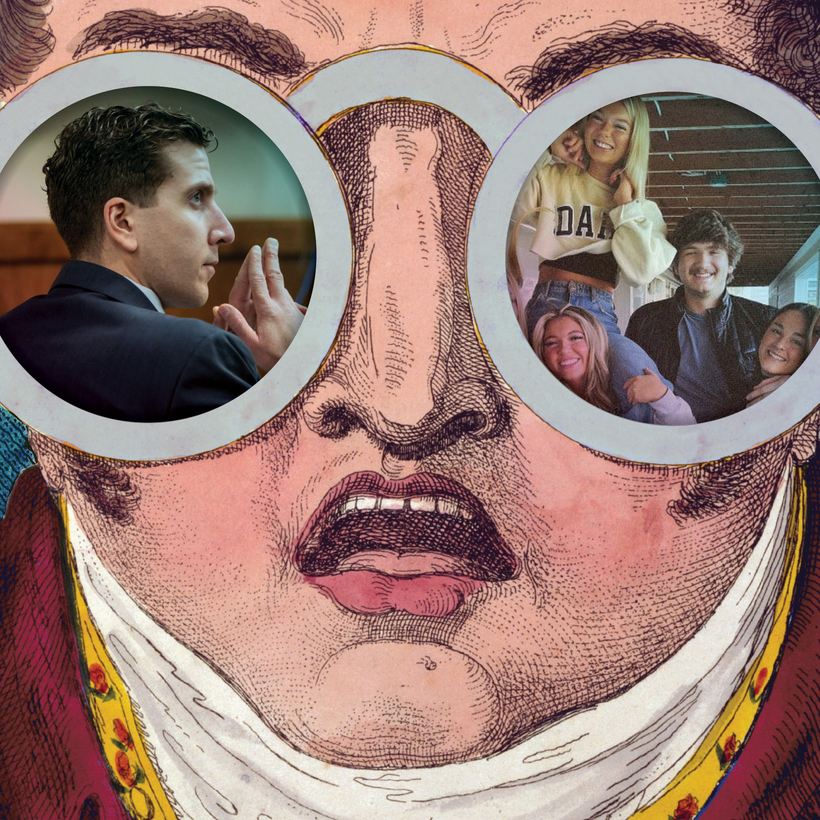People will tell you, justice and vengeance have nothing in common.
They’ll tell you, thank God for the courts. Hurray for the judges and prosecutors who keep it all on the straight and narrow.
But what do they know?
They never sent a child off to college—only to have them come home in a box.
Just before dawn on a still-dark, wintry morning in December 2023, the long crane of an orange Hitachi digger smashed into the three-story house on King Road in Moscow, Idaho, where, a year earlier, a masked assailant had slaughtered four college students. Ninety minutes later the house was razed to the ground, the rubble loaded into a flatbed truck and carted away. “It is time for its removal and to allow the collective healing of our community to continue,” University of Idaho president C. Scott Green solemnly explained.
The memory of this swift, stealthy demolition popped back into my thoughts with a familiar red-hot anger last week. Only now I had been left reeling by the sudden announcement of a settlement in case CR01-24-31665, State of Idaho v. Bryan C. Kohberger.

On July 2, in a Boise courtroom, Judge Steven Hippler accepted the state’s decision to allow the 30-year-old graduate student in criminal justice to plead guilty to the murder of Maddie Mogen, Kaylee Goncalves, Xana Kernodle, and Ethan Chapin. In return, Kohberger will spend the rest of his life in jail; if convicted, he would have faced the long guns of a firing squad.
Like the demolition of the house on King Road, this decision was a hastily brokered resolution, an expedient and coolly pragmatic compromise. And it, too, offered a deeply unsatisfying ending.
The plea deal had been worked out over a summer’s weekend just a month before the start of jury selection for the much-anticipated trial. In the absence of a trial, the case’s many perplexities—seemingly illogical events, missteps by law enforcement, mystifying behavior by surviving witnesses—will remain unresolved. Kohberger’s guilty plea—one terse, indolent recitation of “yes” for each murdered student—was woefully inadequate. Unanswered questions will forever hover around this case.
The Trial That Wasn’t
I admit I never saw this coming. For nearly three years, I had waited with mounting impatience as things crept forward, as scheduled trial dates capriciously came and went, as motions and counter-motions echoed through the courtroom, as the state taxpayers shelled out approximately $3.6 million by April 2024 (according to the Idaho Statesman) to keep the legal process meandering along. But in recent days, I had been buoyed. I felt confident that at last things were heading toward the long-awaited drama of a courtroom battle. But then, without a hint of what was taking shape behind closed doors, the plea deal was announced.
Yet I realize now that I shouldn’t have been surprised. All the signs had always been there. From the get-go, there had been disturbing evidence that honorable men did not have the stomach for the battle that lay ahead. That all along the powers that be in Idaho had been itching to move on.
Consider: The original trial judge, John Judge, couldn’t wait to move the case out of Moscow to Boise; and with that accomplished, he promptly retired. The head of the Moscow-police task force, who spearheaded the seven-week, cross-country investigation, Chief James Fry, teared up on-camera when announcing that he’d gotten his man; a couple of months later, he quietly resigned from the department, only to reappear as chief of police in a town in Washington State.
Hippler, who predicted a three-month trial but wound up approving the state’s plea offer, had announced on his first day presiding over the case, “I’d like to say I’m happy to be here, but why start with an untruth?” And then there was the University of Idaho’s heavy-handed attempt to bulldoze—literally!—all the horrific memories away with its wishful, out-of-sight-out-of-mind thinking.
Nevertheless, the timing of the plea deal still left me baffled. It came in the immediate aftermath of two judicial decisions that further tightened the prosecution’s controlling grip on events. First and more consequentially, the judge had emphatically dismissed the defense’s malicious attempt to suggest that four other individuals were the actual perpetrators and that Kohberger was a patsy; the tell-tale DNA on the knife sheath was indeed his, but the sheath had been planted to incriminate him, they had planned to argue. “Wild speculation,” the judge fumed dismissively after reviewing the defense’s woefully thin evidence. “Nothing links these individuals to the homicides or otherwise gives rise to a reasonable inference that they committed the crime,” Hippler ruled.
Then, in another ominous portent for the defense, the judge ruled that Kohberger’s alibi—the suspect claimed he had traipsed off alone to a wilderness park at four a.m., stargazing on the frigid, cloudy night when the murders had occurred—was “not an alibi.” He refused to allow the defense to tell this fairy tale to a jury.
With less than a month before jury selection, the scrambling Kohberger team had heaved its two final Hail Mary passes, only for both to have been dropped in the end zone.
So how did they manage to keep their client from facing a firing squad, a method of execution that the state legislature had recently made law specifically with the killer of the four Idaho students in mind? And why had the prosecution, victory within its grasp, stopped playing as the fourth quarter commenced? Why had they suddenly walked off the field?
Family Ties
As I poked around, here’s what I discovered.
In recent months, according to the people I spoke with, Anne Taylor, the canny legal-aid lawyer who headed the Kohberger defense team, had apparently come around to the demoralizing realization that her client was guilty. And after a trial, Kohberger would almost certainly be convicted and sentenced to death. So, resigned, she set out to save Kohberger’s life.

When she first approached the graduate student about a plea deal that would prevent his execution, sources tell me that Kohberger weighed it purposefully in his mind. And then he telephoned his 65-year-old mother, MaryAnn. She vehemently opposed the possibility. Why? Perhaps she believed in her son’s innocence. Or maybe she just didn’t want to confront the certain hell that would accompany the recognition of her son’s guilt. What I can state with authority is that she convinced her son to hang in there, and to proceed to trial with his head held high.
So what changed?
Early in May, NBC’s Dateline aired a two-hour episode on the case (for which I had done a minor bit of investigative digging and had also appeared as a talking head). One of the show’s most explosive revelations was the existence of a 54-minute call Kohberger had made at about six a.m., less than two hours after the murders had occurred, to a phone registered to his 70-year-old father.
Only Kohberger and whomever he spoke with know what was said. However, sources familiar with the evidence believe he spoke largely with his mother. For nearly an hour. After which he returned to the vicinity of the King Road house and later posed for his infamous “thumbs-up” selfie.

After the Dateline special made headlines, the family focused for the first time on the now certain knowledge that the prosecution also knew about the lengthy call.
Suddenly it seemed inevitable that Michael and MaryAnn Kohberger would be put on the stand. They would be compelled, under oath, to reveal what was discussed in that early-morning conversation. Michael would also have to testify about what he had discussed with his son as they drove across country, heading home from Washington State to Pennsylvania for the Christmas holidays about a month after the murders.
And so, with the trial at last growing closer and closer, and the defense’s final two desperate strategies ruled nonstarters, Taylor once again begged her client to take a deal. And this time, according to what I heard, when Kohberger conferred with his parents, they allegedly brought up that their futures would be on the line, too, in a trial.
That threw Kohberger for a loop. He fell into a state of near panic. He didn’t, as it was explained to me, feel anything that might resemble guilt. But in his complicated, irrational way, he did feel something akin to a measure of remorse toward his parents. And, no small matter, if a deal could be negotiated, his life would be spared.
He gave Taylor permission to approach Bill Thompson, the Latah County prosecutor. And Thompson jumped at the chance.

Why? With both the prosecution and the defense bound by a gag order, I can only speculate. But here’s an informed guess: Trials, every veteran prosecutor has learned the hard way, are always a throw of the dice. You never know for sure if something new is going to come up, what’s going to land or fall flat with a jury, what prejudices or preconceived notions will color each juror’s interpretation of the facts. No case is ever a sure thing.
So those concerns, as I see it, helped to shape his thoughts. But I think his decision was ultimately forged by something more fundamental: Thompson no longer had the will. After the past two and a half years of immersing himself day after dispiriting day in this sickening tragedy, he had had enough. Maybe he just wanted to spend the summer fishing.
Final Questions
Where did this leave the parents of the murdered children?
No judicial resolution could have sprung them from the life sentences they’re serving. Still, the parents—or at least those who have chosen to share their thoughts—seem pretty much divided into two opposing factions. One group argues with reason: let us get on with our lives and try to heal. The other argues with equal reason: we need answers; we need to know why this happened.
Yet should the opportunity ever come, what questions should be posed to Kohberger? Let me suggest a few:
Why did you choose that victim or target over others?
Did you prepare for the crime before leaving home?
How did you approach the victim or target?
After arriving, what steps did you take locating the victim or target?
After committing the crime, what were you thinking and feeling?
How did you leave the scene?
How was your life right before the crime?
These questions, in fact, might have a familiar ring. They are the ones Kohberger, then studying for his master’s degree in criminal justice at DeSales University, had posted on Reddit with the hope that they would attract the attention and cooperation of bored convicts, whose ranks he will soon join.
And the answers would also explain how Bryan Kohberger, even before he knew it existed, was on his way to the house on King Road.
Howard Blum is the author of several best-selling books, including the Edgar Award–winning American Lightning: Terror, Mystery, the Birth of Hollywood, and the Crime of the Century. His latest, When the Night Comes Falling: A Requiem for the Idaho Student Murders, is available now in paperback


